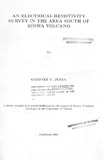| dc.description.abstract | The area south of Suswa volcano is underlain by volcanic and volcano-sedimentary
rocks of the Pliocene-Pleistocene-Recent Periods. These rock types are common waterbearing
formations, especially the wea~hered, fractured or transition zones along faults
and at interfaces of the various volcanic flows. Consequently, any groundwater investigations
are usually based on methods aimed at detecting such underground structures.
Electrical resistivity studies conducted in the area have indicated low resistivities which
appear to be associated with geothermal fluids migrating from the Suswa volcano region.
Hot grounds and fumaroles within the perimeter of Suswa caldera indicate that
. the geothermal system is likely to be directly beneath Suswa volcano. The resistivities
are further rioted to increase southwards. The low resistivities are attributed to high
fluid temperatures and/or conductive minerals within the water-bearing units which
are either weathered or fractured. The actual temperatures of these reservoirs are between
700 and 1000 C which are considerably below those expected for high temperature
geothermal systems. High temperature geothermal areas normally border low temperature
geothermal areas and the present area of study borders the more productive high
temperature Olkaria geothermal fields.
The analysis of resistivity data was first done by partial curve matching prior to the
use of linear inverse theory in the determination of the most probable physical parameters
of the subsurface layers necessary for two-dimensional interpretation of the underlying
geology. From the results, three distinctive layers overlying a resistive half-space
were recognized in terms of their resistivities and thicknesses. The main conductive
layer, which is one of those three layers" immediately overlies the resistive half-space | en |

